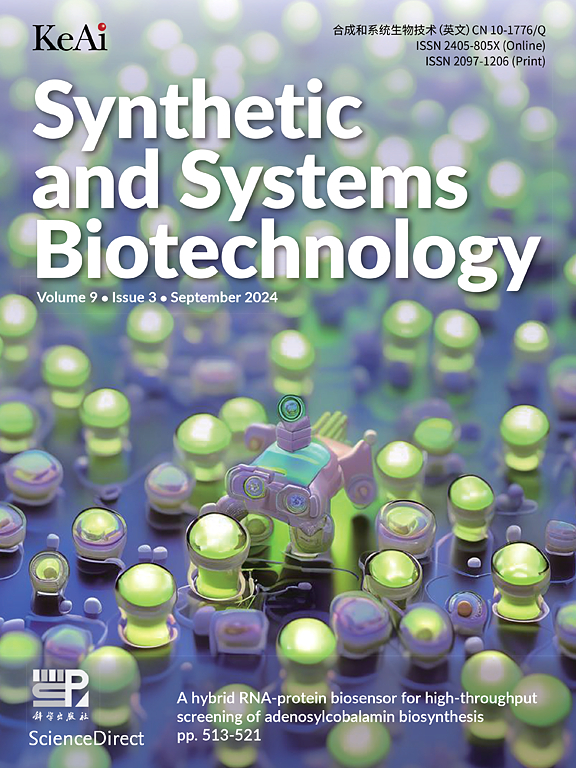Efficient production of 2′-fucosyllactose in Pichia pastoris through metabolic engineering and constructing an orthogonal energy supply system
IF 4.4
2区 生物学
Q1 BIOTECHNOLOGY & APPLIED MICROBIOLOGY
引用次数: 0
Abstract
2′-fucosyllactose (2′-FL) holds significant role in the infants' nutrition. While microbial production of 2′-FL has predominantly utilized Escherichia coli and Saccharomyces cerevisiae, the potential of Pichia pastoris, renowned for its robust NADPH regeneration capability, remains underexplored. Herein, we systematically engineered the metabolism of P. pastoris to develop an efficient 2′-FL-producing cell factory. We first constructed the de novo biosynthesis pathway for 2′-FL in P. pastoris, achieving an initial titer of 0.143 g/L. By optimizing enzyme selection and solubility of α-1,2-fucosyltransferase (FutC), 2′-FL production was enhanced by nearly ten folds. Subsequently, engineering NADPH supply further increased the 2′-FL production by 170 %. Furthermore, we enhanced energy supply by incorporating an orthogonal energy module based on the methanol dissimilation pathway and increasing GTP availability, resulting in a 32 % improvement in 2′-FL production. Finally, through the optimization of fermentation condition, we realized the production titer of 2′-FL to 3.50 g/L in shake-flask, representing the highest titer in P. pastoris. These findings highlight the potential of P. pastoris as a chassis to produce chemicals by providing abundant NADPH and utilizing methanol as co-substrate to supply sufficient energy.
利用代谢工程和构建正交能量供应系统在毕赤酵母中高效生产2′-焦酰基乳糖
2′-焦酰基乳糖(2′- fl)在婴儿营养中起着重要作用。虽然2 ' -FL的微生物生产主要利用大肠杆菌和酿酒酵母,但以其强大的NADPH再生能力而闻名的毕赤酵母的潜力仍未得到充分开发。在此,我们系统地设计了巴斯德酵母的代谢,以开发一个高效的2 ' - fl生产细胞工厂。我们首先构建了2′-FL在pastoris中的从头合成途径,初始滴度为0.143 g/L。通过优化α-1,2-聚焦转移酶(FutC)的酶选择和溶解度,2′- fl的产量提高了近10倍。随后,工程NADPH供应进一步将2 ' -FL产量提高了170%。此外,我们通过结合基于甲醇异化途径的正交能量模块和增加GTP的可用性来增强能源供应,从而使2 ' -FL的产量提高了32%。最后,通过对发酵条件的优化,在摇瓶中实现了2′-FL的生产滴度为3.50 g/L,为P. pastoris的最高滴度。这些发现突出了pastoris作为一个底盘的潜力,通过提供丰富的NADPH和利用甲醇作为共底物提供足够的能量来生产化学物质。
本文章由计算机程序翻译,如有差异,请以英文原文为准。
求助全文
约1分钟内获得全文
求助全文
来源期刊

Synthetic and Systems Biotechnology
BIOTECHNOLOGY & APPLIED MICROBIOLOGY-
CiteScore
6.90
自引率
12.50%
发文量
90
审稿时长
67 days
期刊介绍:
Synthetic and Systems Biotechnology aims to promote the communication of original research in synthetic and systems biology, with strong emphasis on applications towards biotechnology. This journal is a quarterly peer-reviewed journal led by Editor-in-Chief Lixin Zhang. The journal publishes high-quality research; focusing on integrative approaches to enable the understanding and design of biological systems, and research to develop the application of systems and synthetic biology to natural systems. This journal will publish Articles, Short notes, Methods, Mini Reviews, Commentary and Conference reviews.
 求助内容:
求助内容: 应助结果提醒方式:
应助结果提醒方式:


